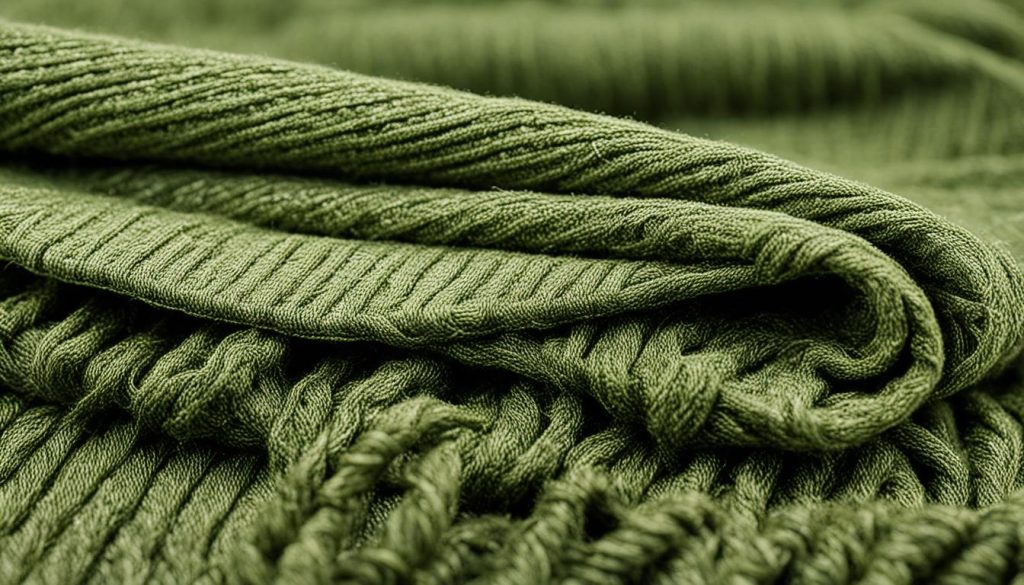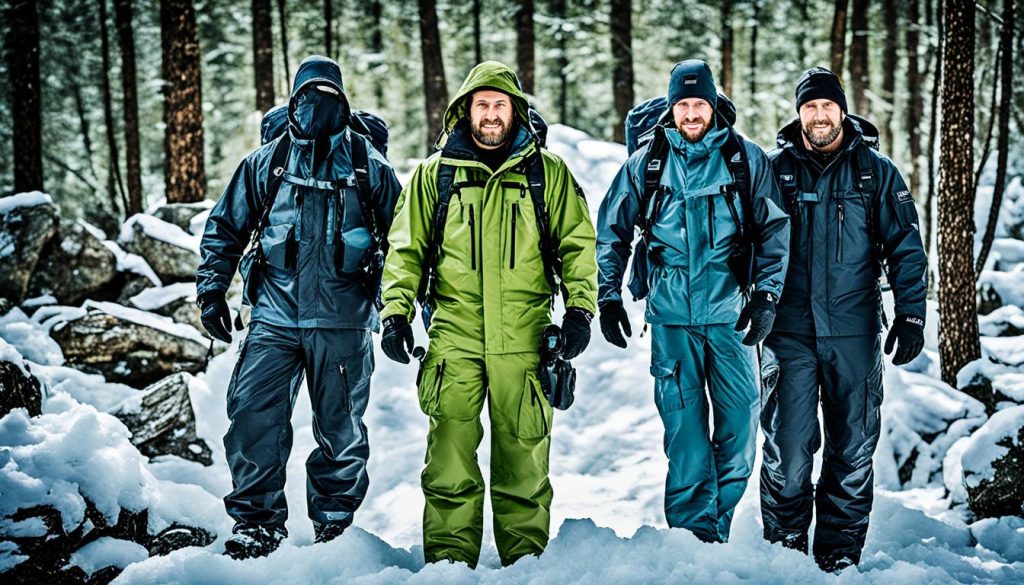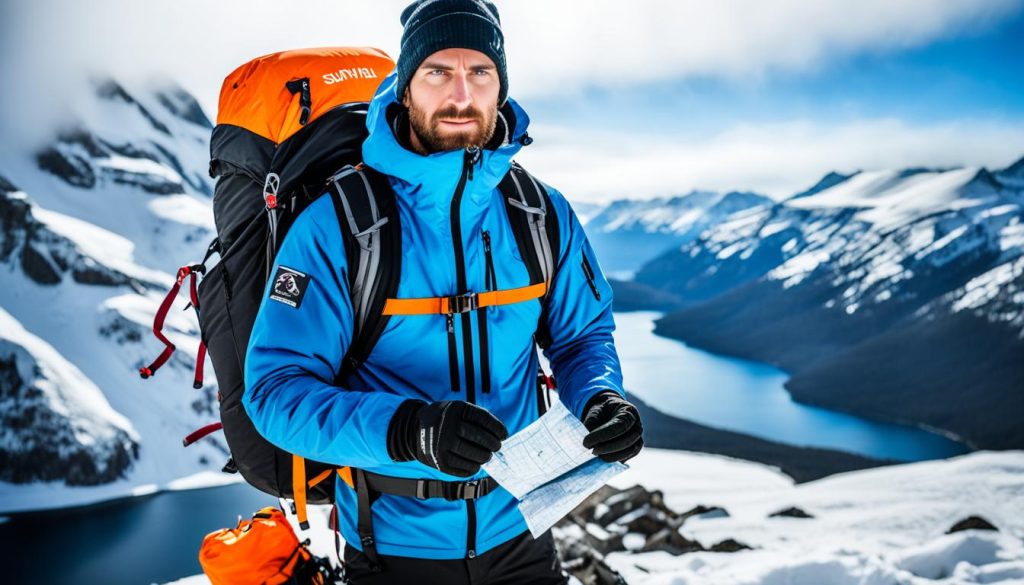Did you know that outdoor enthusiasts face a staggering number of weather-related hazards each year? From freezing temperatures to scorching heat and everything in between, the need for reliable survival clothing is undeniable. Whether you’re a seasoned hiker or an occasional adventurer, having the right gear can mean the difference between life and death.
In this comprehensive guide, we will delve into the world of survival clothing and explore the essential principles and specific types of clothing suitable for different outdoor activities. Discover the importance of layering, the significance of choosing the right materials, and how to cater to the unique needs of each body part. By equipping yourself with the knowledge and gear outlined in this article, you’ll be prepared to face any climate with confidence.
Key Takeaways:
- Survival clothing is crucial for outdoor enthusiasts facing extreme weather conditions.
- Effective survival clothing requires careful consideration of body coverage, the environment, layering, and materials.
- Materials like wool, silk, and poly-fibers play a significant role in providing insulation, moisture resistance, and protection against wind and rain.
- Specific types of survival clothing, including wool pants, rain pants, gloves, and a variety of other essentials, should be included in your kit.
- Adding survival clothing to your daily wardrobe can lead to a more resilient and confident approach to life.
Key Considerations for Effective Survival Clothing
When preparing for outdoor adventures, choosing the right survival clothing is vital for your comfort and well-being. Effective survival clothing takes into account several key considerations to ensure maximum protection and adaptability in various environments. By addressing factors such as body coverage, environmental considerations, layering techniques, and materials, you can create a comprehensive and functional survival clothing kit.
Body Coverage
Effective survival clothing should provide adequate coverage and protection for different parts of your body. This includes the core, hands, feet, legs, head, and neck. Assess the specific needs of each body part in relation to the intended activities and climate. For example, in colder climates, prioritize clothing that has insulation and windproof features, whereas in hotter climates, clothing with moisture-wicking properties and UV protection is essential.
Environmental Considerations
To select the most suitable survival clothing, carefully consider the environment you will be navigating. Different climates and weather conditions require specific types of clothing. If you’re venturing into rainy areas, opt for waterproof or water-resistant materials to keep you dry. In high-altitude locations, clothing that provides thermal insulation helps combat cold temperatures. For hot and humid environments, breathable fabrics enhance comfort and airflow.
Layering for Versatility
Layering is a fundamental technique for effective survival clothing. By wearing multiple layers, you can easily adjust your clothing according to temperature fluctuations throughout the day. With a layered approach, you can add or remove clothing items to regulate your body temperature and maintain comfort. Start with a moisture-wicking base layer, add insulating mid-layers, and finish with an outer shell for weather protection.
Materials Matter
The choice of materials greatly affects the performance of survival clothing. Natural fibers like wool and silk provide excellent insulation and comfort. Wool retains warmth even when wet and is resistant to odors. Silk is lightweight and smooth, making it a comfortable base layer. Synthetic fibers like poly-fibers offer water resistance and windproofing capabilities and are ideal for outer layers. Consider the specific demands of your environment when selecting the appropriate materials for your survival clothing.
| Materials | Insulation | Water Resistance | Other Benefits |
|---|---|---|---|
| Wool | Excellent | Retains warmth when wet | Odor-resistant |
| Silk | Good | Lightweight and smooth | Comfortable base layer |
| Poly-fibers | Varies | Waterproof or water-resistant | Windproof and durable |
Materials for Survival Clothing
The choice of materials plays a vital role in determining the effectiveness and suitability of survival clothing for different conditions. Each material has its unique properties that cater to specific needs. Here, we explore the four key materials commonly used in survival clothing:
1. Cotton
Cotton is a popular choice for outdoor clothing due to its comfort and breathability. However, it is not the best option for survival clothing in cold or wet conditions. Cotton loses its insulating properties when wet and takes a long time to dry, which can lead to discomfort and even hypothermia. Therefore, it is essential to avoid cotton in extreme weather conditions.
2. Wool
Wool is an exceptional material for survival clothing, especially in cooler climates. It offers excellent insulation, even when wet, and retains warmth effectively. Additionally, wool is naturally resistant to moisture, making it suitable for wet environments. Its ability to regulate body temperature makes it a versatile choice for both cold and mild weather conditions.
3. Silk
Silk is an excellent option for a base layer material in survival clothing. It is known for its comfort and breathability. Silk base layers help regulate body temperature by wicking away moisture from the skin. Its lightweight and smooth texture make it ideal for individuals with sensitive skin.
4. Poly-fibers
Poly-fibers, such as Gore-Tex, are synthetic materials commonly used in the outer layers of survival clothing. These materials offer windproof and waterproof properties, ensuring protection against harsh weather conditions. Poly-fibers are durable and lightweight, making them ideal for rugged outdoor activities.
When assembling your survival clothing kit, consider a combination of these materials to cater to different climate conditions and activities. Layering clothing with a mix of wool, silk, and poly-fiber garments provides versatility and adaptability. Remember to prioritize the specific needs of the environment you will be in when selecting materials.
| Material | Benefits | Suitability |
|---|---|---|
| Cotton | Comfortable, breathable | Not suitable for cold or wet conditions |
| Wool | Excellent insulation, retains warmth even when wet | Ideal for cooler climates and wet environments |
| Silk | Comfortable, lightweight, regulates body temperature | Effective base layer material |
| Poly-fibers | Windproof, waterproof, durable | Ideal for outer layers in harsh weather |
Specific Types of Survival Clothing
When it comes to outdoor activities, having the right survival clothing is crucial for your comfort and safety. In this section, we will explore essential items that should be included in any survival clothing kit. From wool pants to rain ponchos, these items are designed to protect you from the elements and ensure your readiness in any situation.
Wool Pants
Wool pants are a staple in survival clothing. They offer excellent insulation and durability, making them perfect for colder climates and rugged terrains. Whether you’re hiking, camping, or adventuring in the wilderness, wool pants provide reliable protection and keep you warm.
Rain Pants
For wet weather conditions, rain pants are essential. They are designed to repel water and keep you dry even in heavy downpours. Rain pants provide an extra layer of protection, allowing you to continue your outdoor activities without getting soaked.
Wool Socks
Keeping your feet warm and dry is vital in outdoor environments. Wool socks are excellent for insulation and moisture-wicking, preventing blisters and discomfort. Invest in high-quality wool socks to ensure optimal comfort and protection.
Wool Shirts
Wool shirts are available in both thin and thick varieties, making them versatile options for survival clothing. Thin wool shirts provide a base layer of insulation, while thick wool shirts offer extra warmth in colder climates. Their natural fibers provide excellent breathability and temperature regulation.
Fleece Sweater
A fleece zippered sweater is a valuable addition to your survival clothing kit. It serves as a versatile mid-layer option, providing insulation and comfort. Fleece sweaters are lightweight, breathable, and quick-drying, making them ideal for layering in various weather conditions.
Gloves
Protecting your hands from cold temperatures is essential, especially in extreme climates. Wool glove liners and poly-fiber gloves offer different levels of insulation and dexterity. Wool glove liners provide added warmth, while poly-fiber gloves offer waterproof and windproof properties.
Wool Jacket
A wool jacket acts as an outer layer, providing exceptional protection against harsh weather conditions. It offers insulation, moisture resistance, and durability. A wool jacket is a reliable piece of survival clothing that should not be overlooked.
Beanie Hat
To keep your head warm, a beanie hat is a must-have item in your survival clothing kit. It helps retain body heat and protects your ears from cold winds. Made from wool or other insulating materials, a beanie hat ensures your comfort in colder climates.
Rain Poncho
A rain poncho is a versatile piece of survival clothing that serves multiple purposes. Not only does it protect you from rain, but it can also be used as an emergency shelter or to cover your gear. Lightweight and compact, a rain poncho is a valuable addition to your survival gear.
Make sure to include these specific types of survival clothing in your outdoor adventures. They are essential for your comfort, safety, and readiness in all weather conditions.
Additional Tips for Survival Clothing
In addition to selecting the right clothing and materials for your survival gear, there are a few additional tips that can greatly enhance the effectiveness of your survival clothing. By incorporating these tips, you can maximize insulation, improve repairability, and showcase ingenuity in your gear selection and usage.
Understanding Insulation
One key tip is to gain a deeper understanding of how insulation works. While traditional insulation materials like synthetic fibers and down are widely used, there are often natural materials readily available in your outdoor environment that can provide additional warmth. For example, consider utilizing leaves or other plant materials as insulation layers in your clothing. Simply tucking a few leaves between layers can create extra pockets of warmth, especially in emergency situations or during extreme cold weather.
Additionally, you can take a hands-on approach to maximize insulation by making alterations to your clothing. By creating small spaces or pockets within your gear, you can easily insert natural insulation materials like dried grass or even small air-filled pouches to lock in warmth.
Prioritizing Repairability and Ingenuity
When selecting and using survival clothing, it’s essential to prioritize repairability and ingenuity. Invest in gear that is designed with repairability in mind, such as clothing with reinforced stitching or easily replaceable components. By choosing gear that can be repaired when damaged, you can extend the lifespan of your clothing and avoid the need for constant replacements.
Remember, when it comes to survival clothing, ingenuity is key. Don’t be afraid to think outside the box and come up with creative solutions to address specific challenges or needs. Your gear should be adaptable and versatile, able to meet various unexpected situations that may arise during your outdoor adventures.
Another tip to showcase ingenuity is to test your survival clothing in different environments and weather conditions. This allows you to gain firsthand experience and assess the performance of your gear. By testing your clothing and equipment in advance, you can identify any weaknesses or areas for improvement, enabling you to make necessary adjustments and ensure the reliability of your gear when it matters most.
By incorporating these additional tips into your approach to survival clothing, you can enhance the insulation capabilities of your gear, prioritize repairability, and demonstrate ingenuity in your gear selection and usage.
Improving Daily Wardrobe with Survival Clothing
Survival clothing doesn’t have to be limited to emergency situations. By integrating survival clothing into your daily wardrobe, you can prioritize function over fashion and choose durable and functional options that will last for years.
When it comes to survival clothing, the focus should be on timeless pieces that are appropriate for your lifestyle. Instead of following fast fashion trends, opt for high-quality clothing that can withstand the test of time.
Incorporating survival clothing into your daily wardrobe can lead to increased confidence and a more active outdoor lifestyle. Whether you’re running errands or exploring the great outdoors, you’ll be prepared for any situation.
In your search for survival clothing, prioritize materials and construction over brands and stores. Look for durable options that are designed to withstand the elements. Clothing made from rugged fabrics like nylon and polyester can offer excellent durability and resistance to wear and tear.
A key benefit of integrating survival clothing into your daily wardrobe is the versatility it offers. Pieces like waterproof jackets, insulated pants, and sturdy boots can be worn in various settings, from casual outings to outdoor adventures.
By choosing function over fashion, you’re investing in clothing that is built to last and perform well in any situation.
Functionality should be at the forefront of your decision-making process when selecting survival clothing. Look for features like multiple pockets, adjustable cuffs, and reinforced stitching that enhance the practicality of the garments.
Remember, survival clothing is designed to provide protection and functionality. While style is important, it should not be the sole focus. Prioritize clothing that is designed to endure rugged conditions and keep you comfortable in various climates.
The Benefits of Timeless Clothing
One of the advantages of incorporating survival clothing into your daily wardrobe is the timeless nature of these pieces. Timeless clothing transcends trends and can be worn year after year without going out of style.
Investing in timeless pieces allows you to create a versatile wardrobe that can be easily mixed and matched. By building a collection of durable and functional clothing, you reduce the need to constantly buy new items, contributing to a more sustainable and eco-friendly approach to fashion.
Timeless clothing also gives you the freedom to express your personal style without being limited by temporary trends. These pieces are designed to be versatile and can be dressed up or down depending on the occasion.
When choosing timeless clothing, focus on classic designs and neutral colors that are easy to coordinate. This ensures that your wardrobe remains cohesive and adaptable to different situations.
| Benefits of integrating survival clothing: | Timeless clothing tips: |
|---|---|
| Increased confidence and active lifestyle | Focus on classic designs and neutral colors |
| Durable and functional options | Invest in high-quality, long-lasting pieces |
| Versatility for various settings | Create a versatile and cohesive wardrobe |
| Protection and practicality | Choose materials and construction over brands |
Integrating survival clothing into your daily wardrobe is a smart and practical choice. It allows you to prioritize function over fashion while still maintaining your personal style. By investing in durable and timeless pieces, you can create a wardrobe that keeps you prepared for any situation without compromising on style.
Furthermore, embracing timeless clothing contributes to a more sustainable and eco-friendly approach to fashion by reducing waste and unnecessary consumption.
So, why not elevate your daily wardrobe with the durability and functionality of survival clothing? Start integrating these versatile pieces into your outfit choices and experience the benefits they bring to your everyday life.
Learn more about the environmental impact of the fashion industry and the importance of making conscious clothing choices.
Choosing Prepper Clothing on a Budget
Building a prepper wardrobe doesn’t have to break the bank. When it comes to finding the right prepper clothing, you can prioritize quality and affordability without compromising on lightweight, durable, and stylish options. By considering the materials, construction, and timeless styling, you can create a budget-friendly collection of clothing that meets your prepping needs.
Materials
When shopping on a budget, it’s important to look for clothing made from materials that offer a combination of durability and affordability. Natural fibers like cotton and wool are excellent choices. Cotton is lightweight, breathable, and inexpensive, making it suitable for base layers and shirts. Wool, on the other hand, is known for its insulating properties, durability, and natural wicking ability. It may be slightly more expensive than cotton, but it will last longer and perform better in various weather conditions.
Additionally, consider synthetic materials like nylon and polyester. These materials are often lightweight, moisture-wicking, and quick-drying, making them ideal for outer layers and pants. They can withstand wear and tear while providing good abrasion resistance.
Construction
When choosing prepper clothing on a budget, pay attention to the construction of the garments. Look for reinforced stitching, sturdy zippers, and well-made seams. Quality construction ensures that the clothing will withstand rugged outdoor activities and frequent use. While some budget-friendly options may skimp on construction, it’s still possible to find well-made clothing without overspending.
Styling
Opting for timeless styles is a smart choice when building a budget-friendly prepper wardrobe. Classic designs never go out of fashion and can be worn across different seasons and situations. Neutral colors such as black, gray, and earth tones offer versatility and allow for easy mixing and matching. By focusing on timeless clothing, you can invest in pieces that will remain functional and relevant for years to come.
Remember that simplicity often translates into cost-effectiveness and versatility. Avoid overly trendy or flashy designs, as they may quickly go out of style or become impractical in a survival situation.
Lightweight and Durable Options
When searching for prepper clothing on a budget, keep an eye out for lightweight and durable options. Lightweight clothing ensures ease of movement and reduces the burden of carrying heavy gear. Durable materials and solid construction allow the clothing to withstand rugged outdoor activities, ensuring that it won’t easily tear or wear out. By prioritizing these qualities, you can find affordable clothing that will last through countless adventures.
Conclusion
Survival clothing is an essential part of any outdoor enthusiast’s gear. To ensure you are prepared for any climate, it is important to consider the principles of effective clothing. By choosing the right materials and selecting appropriate types of clothing for different environments, you can stay comfortable and protected.
Layering is a key element of survival clothing, allowing you to adjust your clothing according to temperature fluctuations. Insulating materials like wool and synthetic fibers provide warmth and protection. Additionally, functional design ensures that your clothing meets the specific needs of different outdoor activities.
Integrating survival clothing into your daily wardrobe not only prepares you for unexpected situations but also cultivates a more resilient and confident approach to life. By prioritizing durability, repairability, and ingenuity, you can rely on your clothing to withstand rugged conditions and adapt to various challenges. Remember, your choice of survival clothing can make a significant difference in your outdoor experience.



